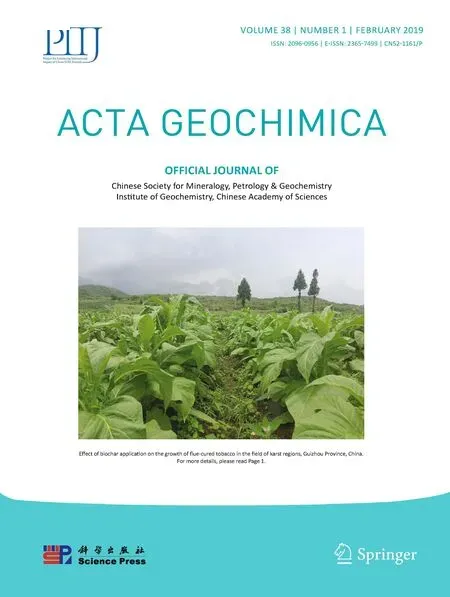Jurassic granitoid dike in Luodian,Guizhou Province:discovery and geological significance
Mingjin Zhu·Aiguo Nie·Yazhou Tian·Xinsong Wang·Jun Sun
Abstract In this paper,the Jurassic granitoid dike that intrudes into Permian diabase was reported in Luokun,Luodian County,south Guizhou.Zircon LA-ICP-MS U-Pb dating of the granitoid dike yielded an age of 164.3 ± 2.4 Ma with the εHf(t)range from+7.8 to+12.1.The high contents of SiO2(65.2%-66.8%)and total alkali(Na2O+K2O:9.01%-9.95%),and low contents of Mg,Fe,Ca,P and Ti show the characteristics of alkali-rich granite.The total contents of rare earth elements range from 289.90 to 394.23 ppm.The Rb,Ba,K,Th,U and other LILE,Ta,Sr,P,Ti are enriched,and heavy rare earth elements are depleted.Petrogeochemical characteristics show that the dike was derived from a partial melting of newly-grown basaltic crust,and contaminated by crustal materials before experiencing strong fractional crystallization.The dike was formed in the intraplate post-orogenic extension stage and indicates that parental magma rose to the shallow crust through a fault.This provides new evidence of tectonic and mantle-crust magmatic activities and may contribute to regional Au mineralization in southern Guizhou and neighboring areas.
Keywords Jurassic granitoid dike·Geochemical characteristics·Geochronology·Luodian·Guizhou province
1 Introduction
In Guizhou province,which is mainly covered by sedimentary rocks,igneous rocks are scattered in small areas;examples include the Permian basalts in the west of Guizhou,Late Cretaceous and Permian basic-ultrabasic rocks in the west and south of Guizhou,and the huge granites of the Xuefeng period occurring at the Jiuwandashan area on the border between Guizhou and Guangxi,as well as in Guangxi.Strong epithermal mineralization developed in the west and north of Guizhou,such as Carlin-type Au mineralization(Hu and Zhou 2012),the mineralization age of which spanned largely from 134 to 193 Ma(Chen et al.2007;Zheng 2017;Liu et al.2017;Su et al.2018).Research shows that those mineralization sources may be associated with deep magmatism(Su et al.2009;Xia et al.2009;Liu et al.2017;Xie et al.2018)but there has been no contemporaneous magmatic event reported in west Guizhou.In recent years,the granitoid dike that intruded in Permian diabase was discovered in Luokun,Luodian County south Guizhou.The petrology,geochemistry,zircon U-Pb dating,and Hf isotope of the dike were analyzed in this paper.The petrogenesis and age of the dike will be very crucial for us to understand the regional mineralization mechanism and tectonic episode.
2 Regional geological setting
The study area is located at the transition zone of the southwest Yangtze Plate and Youjiang Orogenic Belt(Fig.1a),and belongs to the inner edge of the southwest margin of Yangtze Plate(Wu et al.1997a,b).The convergence of Yangtze Plate and Huaxia Plate,as well as the accompanied folding and magmatic activity in the Caledonian period has limited the ancient tectonic framework of this region(Shu 2006).
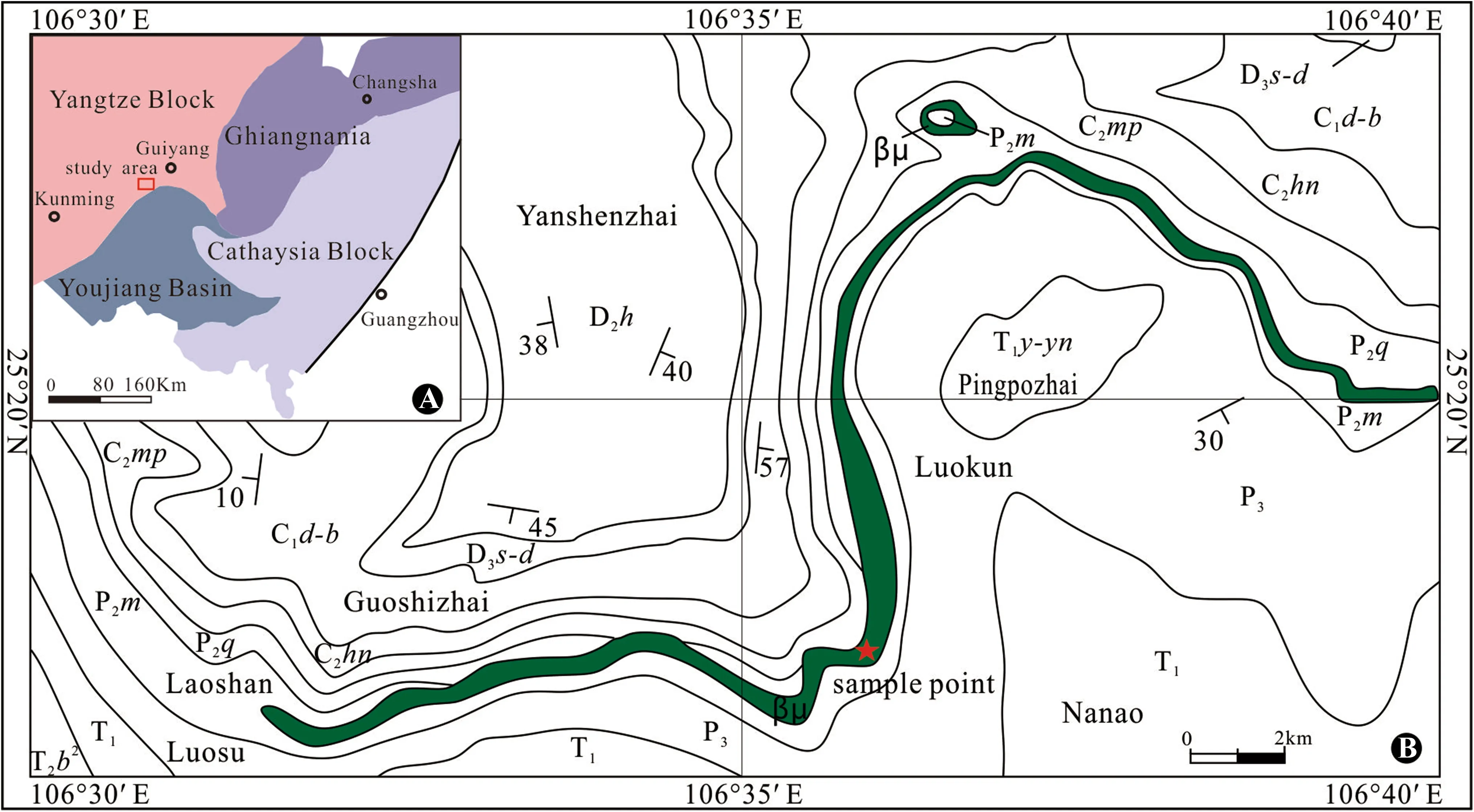
Fig.1 Geological map of the granitoid(A-modified from Chen et al.1994;B-modified from the geologic map of Luodian and Leye,1:200,000).T2b2-Midpiece of Bianyang Formation of Middle Triassic;T1-Lower Triassic;P2m-Maokou Formation of Middle Permian;P2q-Qixia Formation of Middle Permian;C2mp-Maping Formation of Upper Carboniferous;C2hn-Huanglong Formation of Upper Carboniferous;C1d-b-Datang-Baizuo Formation of Lower Carboniferous;D3s-d-Xiangshuidong Formation-Daihua Formation of Upper Devonian;D2h-Huohong Formation of Middle Devonian;βμ-Diabase
In Late Paleozoic,basic magmatic activity was widely developed in the middle and northern areas of Guangxi(Wang and Kuang 1997;Zhang et al.1999;Wu et al.1993,1997).Then,in Middle and Late Permian,due to the intense activity of mantle plume and a huge eruption of Emeishan basalt,the extremely thick continental flood tholeiitic basalts accumulated in southwest Guizhou with a maximum thickness of over 2000 m(Xu et al.2001;Chen et al.2003).In the late Yanshanian,the lithosphere extended and the accompanied acidic magmatic activity was very intensive in Guangxi,which contributed to the world-class tin polymetallic deposit(Hu and Zhou 2012).
However,in southern Guizhou,the magmatic activity was relatively weak,characterized mainly by the large development of sedimentary rocks in this period.The main strata outcrops in the area are Devonian,Carboniferous,Permian and Triassic sediments,and Permian diabase(Fig.1b).The diabase mainly emplaces in the limestone of the Middle Permian Maokou Formation as bedrock or dike and locally invades in the Middle Permian Qixia Formation and Upper Carboniferous strata with an inclination angle of 50°-60°and an exposed width of 15-315 m,and usually 100-200 m.The 261.9±2.1 Ma of Zircon SHRIMP dating of the diabase was considered to be the polymorph product of Late Permian Emeishan basalt(Zhu et al.2018).The granitoid dike cut across the diabase,indicating that it was formed after the Permian.
3 Geological and petrographic characteristics of the granitoid dike
Eight parts can be identified from the section of field outcrop of the granitoid dike(Fig.2).(1)the normal limestone of P2m;(2)the marble from the hydrothermal alteration of P2mlimestone,many calcite and quartz veins are in the limestone;(3)fine-grain fresh diabase;(4)coarse-grain fresh diabase;(5)fine-grain diabase with spherical weathering;(6)granitoid dike;(7)altered diabase;the diabese has been altered into clay;and(8)normal limestone of P2m.The granitoid dike nearly vertically intruded in diabase with an occurrence of 95°∠85°and a width of about 50 cm.The contact between the diabase and the granitoid dike is unambiguous.

Fig.2 The cross-section of field outcrop of the granitoid
Field observations and thin section identification under a microscope have been carried out on the granitoid dike.The rock is pale gray and blocky,and feldspar phenocrysts are visible on hand sample.Phenocrysts that consist mainly of plagioclase(70%)and perthite(20%)are mostly rectangular or tabular(Fig.3a,b)in the porphyritic texture,in which phenocrysts account for about 90%and the matrix accounts for about 10%(Fig.3c,d).Plagioclase is automorphic or hypautomorphic,uniformly distributed in the plate column shape,and it develops multiple twins with a size of 0.2-3 mm and suffered weak sodium-zoisitization.Perthite is automorphic or hypautomorphic in a thin strip shape with the size of 0.5-1.5 mm.The matrix is composed of biotite(9%)and quartz(1%).Biotite is distributed between the crystals of plagioclase and perthite as the incomplete leaf and fragment shape with the size of 0.02-0.2 mm.We suggest that the plagioclase and perthite were the primary mineral phase during the magmatic process,and the source magma of granitoid was enriched in Na and K.The biotite and quartz were late-magmatic accessory phases,and the zoisite was the product of hydrothermal alteration.

Fig.3 Features under microscope and field of the granitoid.a,b Contact relationship between granitoid dike and diabase;c,d photomicrographs of granitoid(cross-polarized);Qtz-quartz;Pl-plagioclase;Pth-perthite;Zo-zoisite;Bt-biotite

Table 1 continued
4 Samples and analysis method
The samples are located on the side of the road in the southwest of Luokun,Luodian County.Based on detailedfield observation of the hypabyssal dike,LK2 was taken from the center of the dike and LK1 and LK2-1 were taken from 20 cm from the center on both sides.All samples were fresh rocks.
The major element,trace element,and rare earth element analysis of three whole-rock samples were completed in the ALS Laboratory(Guangzhou)Co.,Ltd.In the major element analysis,the fuse XRF method was adopted for determination and the plasma spectrometry and chemical method were adopted for mutual detection.In the rare earth and trace element analysis,LA-ICP-MS was adopted for testing.
Zircons selection in rocks was conducted in Yuneng Rock and Mineral Separation Technology Service Co.,Ltd.in Langfang,Hebei.CL photographs of zircons were taken in the Key Laboratory of Continental Tectonics and Dynamics of Chinese Academy of Geological Sciences.Ziron U-Pb isotopic age and Lu-Hf isotopic analysis werefinished with Neptune and other MC-ICP-MS in the isotopic laboratory of Tianjing Institute of Geology and Mineral Resources.A 193 nm excimer laser sampling system(LA-MC-ICP-MS)was adopted for zircon laser ablation.During zircon U-Pb dating,the spot beam of laser ablation was generally 35 μm,the energy density was 13-14 J/cm2and the frequency was 8-10 HZ.The laser ablation material was sent to Neptune(MC-ICP-MS)with He as the carrier gas.TEMORA and GJ-1 were taken as the external zircon age standards for U and Pb isotope fractionation correction.The detailed experimental process referred to Geng et al.(2012)and Li et al.(2009a,b).ICPMS Data Cal program was adopted to make data processing(Liu et al.2010).208Pb was used to correct common lead(Anderson 2002)and NIST612 was taken as the external standard to calculate the contents of Pb,U,and Th in zircon samples.Isoplot program was adopted for statistical processing(Ludwing 2001).The error of individual data points was 1σ.206Pb/208U was taken as the age and its weighted average was 95%of confidence level.
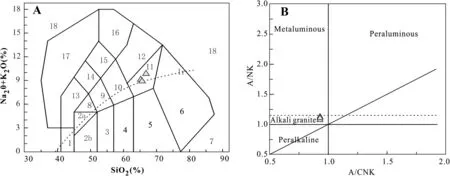
Fig.4 a TAS diagram and b A/CNK-A/NK diagram of the granitoid(after Maniar and Piccoli 1989).a TAS diagram of granitoid in Luodian;1-olivine gabbro;2a-alkali gabbro;2b-inferior alkali gabbro;3-gabbrodiorite;4-diorite;5-granodiorite;6-granite;7-quartzolite;8-monzogabbro;9-monzodiorite;10-monzonite;11-quartz monzonite;12-syenite;13-foid quartz monzogabbro;14-foid monzogabbro;15-foid monzosyenite;16-foid syenite;17-foid plutionic rock;18-tawite/urtite/italite;Ir-Irvine alkaline above the boundary line and sub-alkaline below the boundary line;a,acidity rock in Luodian A/NK-A/CNK diagram(the base refers to Literature(Maniar and Piccoli 1989);A/CNK=Al2O3/(CaO+Na2O+K2O),A/NK=Al2O3/(Na2O+K2O)are all molar ratios
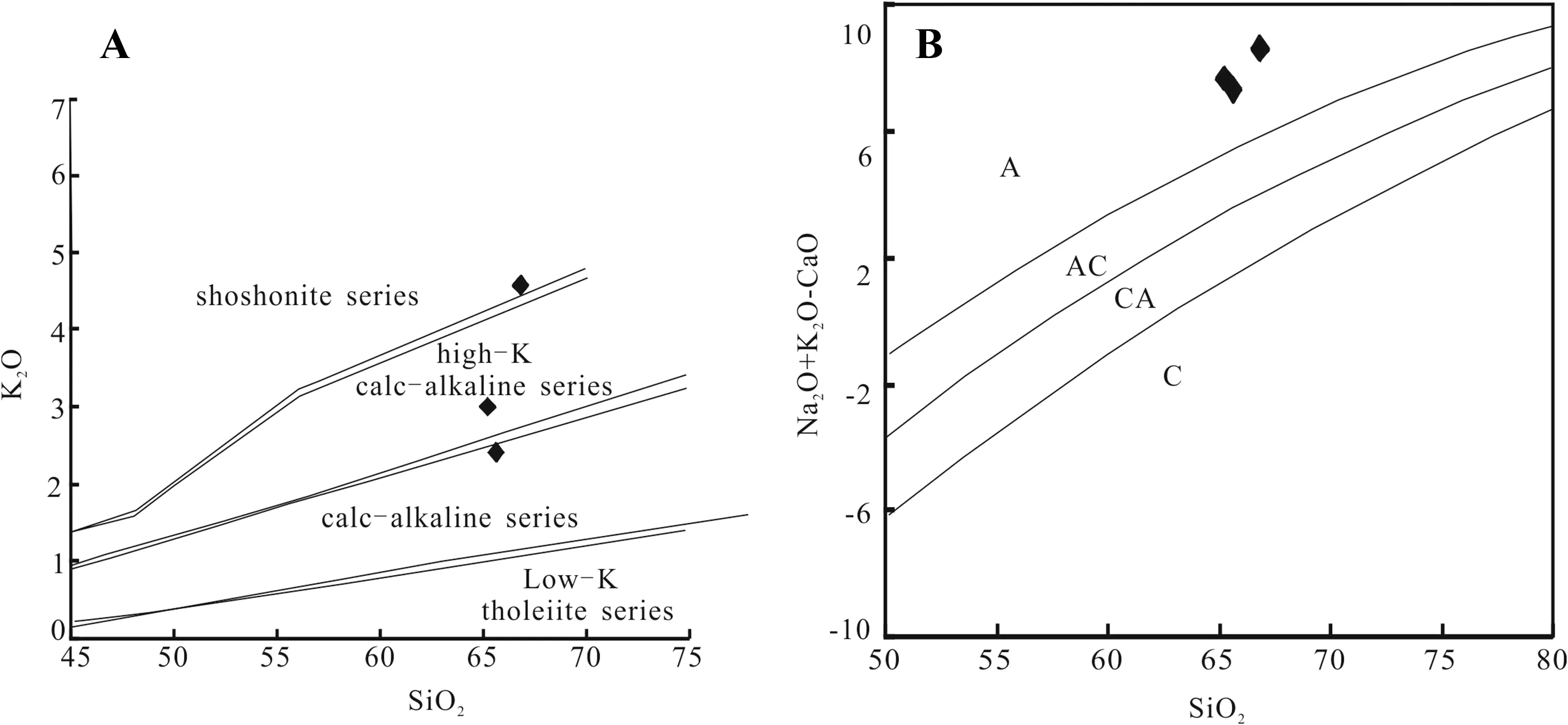
Fig.5 a Si2O-K2O diagram of the granitoid(after Peccerillo and Taylor 1976)and b(Si2ONa2O+K2O-CaO)diagram of the granitoid(after Frost et al.2001)
In Lu-Hf isotopic analysis,8-10 Hz laser frequency,100 mJ laser intensity,and 50 μm laser beam spot diameter were adopted.Laser ablation material was sent to Neptune with He as the carrier gas.GJ-1 was taken as the monitoring standard sample.In order to make Hf isotopic analysis correspond to zircon U-Pb age analysis,zircon Hf isotopic analysis points and zircon U-Pb age analysis points were located at the same place or structure of the same zircon crystal zone.1.867×10-11/year was used to calculate the decay constant of176Lu.The ratios of176Lu to177Hf and176Hf to177Hf of chondrite were 0.0332 and 0.282772,respectively.The ratios of176Lu to177Hf and176Hf to177Hf of depleted mantle were 0.0384 and 0.28325,respectively.The ratio of176Lu to177Hf(average crust)was 0.015.The detailed test process referred Geng et al.(2011).
5 Results
5.1 Rock geochemistry results
The major and trace element data of the whole-rock are shown in Table 1.The rock has high contents of SiO2(65.2%-66.8%)and total alkali(Na2O+K2O:9.01%-9.95%)and low contents of MgO(0.50%-0.56%),Fe2O3(3.54%-4.69%),CaO (1.38%-1.73%),P2O5(0.10%-0.21%),and TiO2(0.63%-0.81%),showing the characteristic of rich alkali granite.In the TAS classification diagram(Middlemost 1994),three samples are all located in quartz monzonite area(Fig.4a)belonging to the alkaline series,which is consistent with the identification results of lithology.In the A/CNK-A/NK diagram,there are three acidic rock samples.A/CNK(0.93≤1.0)belongs to the aluminum alkaline granite(Fig.4b).Three samples are distributed dispersedly in the Si2O-K2O diagram(Fig.5a),but they all fell into the alkaline series.The main oxides,Al2O3,Fe2O3T,MgO,CaO,Na2O,P2O5,are negatively related to SiO2in Harker plot(Fig.6).
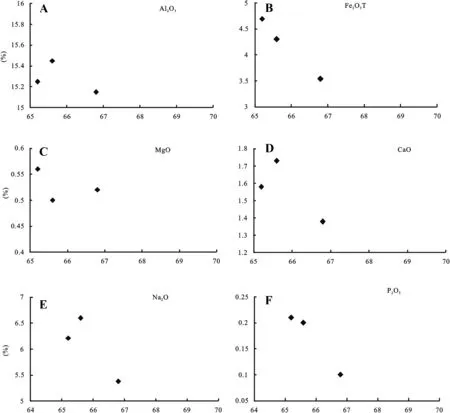
Fig.6 Harker diagrams for the granitoid
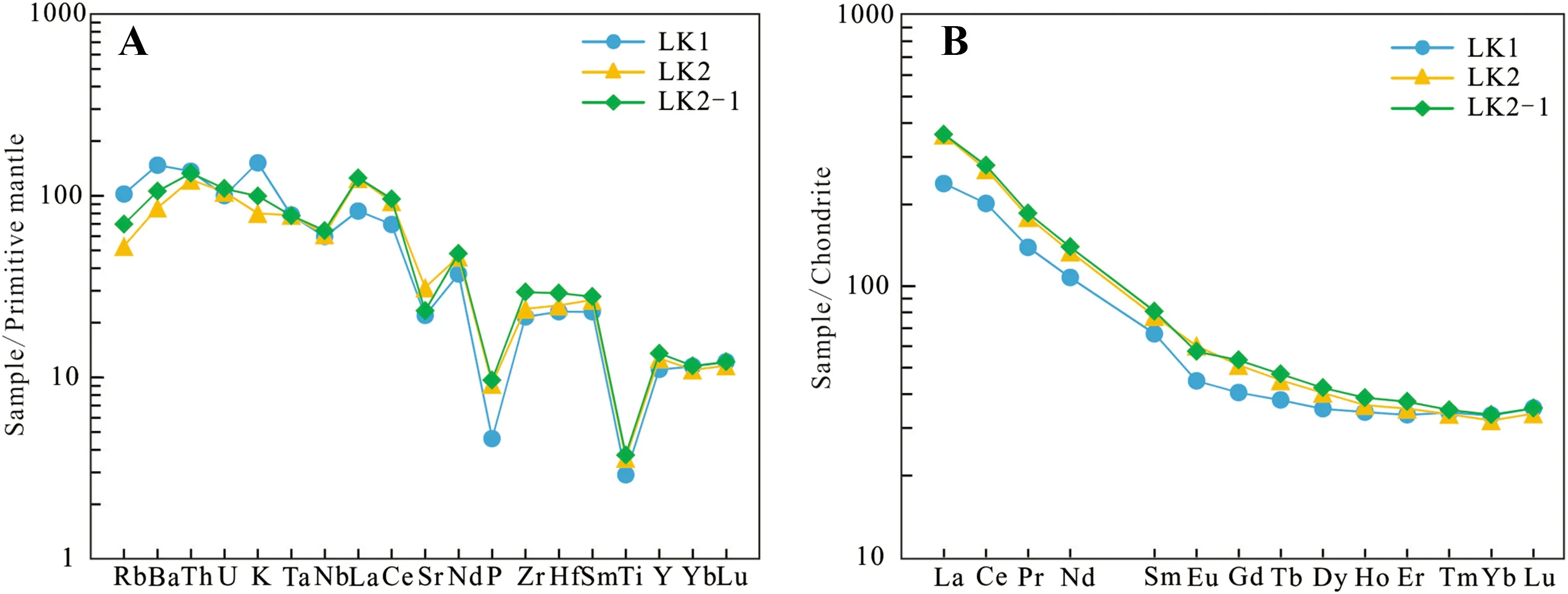
Fig.7 Primitive mantlenormalized trace element spidergrams(a)and chondritenormalized REE patterns(b)diagrams of the granitoid.a modified after Sun and McDonough(1989);b modified after McDonough and Sun(1995)
The total contents of rare earth elements ranged from 289.90 to 394.23 ppm;La/Yb ranged from 9.98 to 15.78;δEu ranged from 0.83 to 0.94,indicating slight Eu anomaly.The rare earth element distribution map was rightdipping(Fig.7b),but medium and heavy rare earth elements were relatively flat without significant depletion.According to the trace element spider diagram(Fig.7a),relative to enriched light rare earth elements,Rb,Ba,K,Th,U,and other LILE,Ta,Sr,P,Ti and heavy rare earth elements depleted.In addition,granitoid in Luodian had relatively low 10,000 Ga/Al(1.67-1.96),FeO*/MgO(6.13-7.74)and Sr/Y(8.61-11.59),and it doesn't show the characteristics of adakitic granite.
5.2 Zircon U-Pb dating result
Zircon U-Pb dating results showed that the206Pb/238U age ranged widely from 2632 to 161 Ma with multiple ranges overall, including 161-168 Ma, 257-280 Ma,407-499 Ma,975-1105 Ma,1405-1520 Ma,~1800 Ma,2135-2208 Ma,and~2632 Ma(Table 2).It could be seen from CL pictures(Fig.8)that those zircons had goodzonal structure.The ratios of Th to U of zircons were all bigger than 0.4,reflecting the characteristics of magmatic zircon(Wu and Zheng 2004).However,such a large age range indicated that a lot of zircons in the old crust were captured by later magmatism.In other words,many zircons were the inherited magmatic zircons.Among them,6 zircons had the youngest and concentrated ages(161-168 Ma) with the weighted average age of 164.3±2.4 Ma(Fig.9).

Table 2 continued
5.3 Hf isotopic characteristics
Zircon Hf isotopic data is shown in Table 3.According to the results,6 zircons with 161-168 Ma had εHf(t)value range from+7.8 to+12.1;the model age TDM2of the depleted mantle was between 727 and 1112 Ma.The εHf(t)value of zircon with 268 Ma was+4.5 and TDMwas 747 Ma.The εHf(t)value of zircon with 278 Ma was-20.6 and TDMwas about 1716 Ma.The εHf(t)value of zircon with 442-499 Ma ranged from-7.5 to+13.4 and TDMwas between 549 and 1395 Ma.
6 Discussions
6.1 Age of granitoid
As mentioned above,among the zircon samples from the granitoid dike in Luodian,there are many inherited zircons whose age peaks correspond to that of detrital zircons in the bauxite stratum in northern Guizhou(Jing et al.2013;Jin et al.2013).This indicates the mixing of shallow crust materials.According to the field geology,the granitoid dike in Luodian directly intruded and cut across the diabase.The age of the diabase was 261.9±2.1 Ma,which was close to the age of the xenocrystic zircons from 257 to 280 Ma.This indicates that the formation age of the dike was later than 261.9 Ma.From the zircon dating results of the dike,it has been found that the only zircons with the age of 161-168 Ma were later than 261.9 Ma,they have similar ages,and they have obvious magmatic bands.Their ages could represent the crystallization age of granitoid dike.Moreover,the zircons with ages older than 975 Ma suggest the widespread presence of unexposed Proterozoic and Archean basement in southwest Yangtze craton,which is similar to that of zircons in east Guizhou(Zheng et al.2006).
6.2 Source of the granitoid
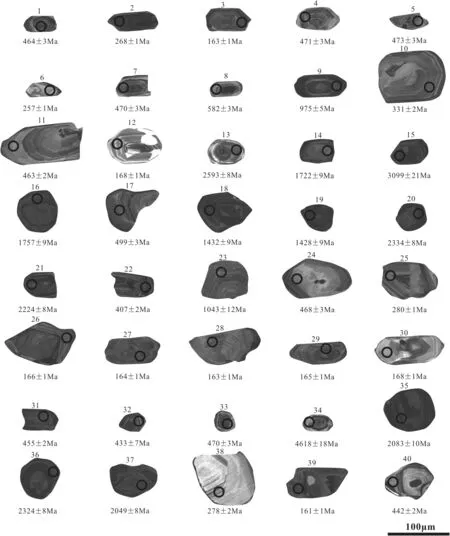
Fig.8 CL photomicrographs of zircons
Granitoid in Luodian had high contents of SiO2(65.2%-66.8%)and total alkali(Na2O+K2O:9.01%-9.95%)and low contents of Mg,Fe,Ca,P and Ti,showing the characteristics of rich alkali granite(Bi et al.2000).It had low 10,000 Ga/Al(1.67-1.96)and FeO*/MgO(6.13-7.74),indicating that it had no characteristics of A type granite(Whalen et al.1987).Its relatively low A/CNK value(0.93)reflects that it had no characteristics of S type granite,either.However,its relatively low P2O5content(0.10%-0.21%)shows that it has certain characteristics of I-type granite(Chappell and White 1992,2001).
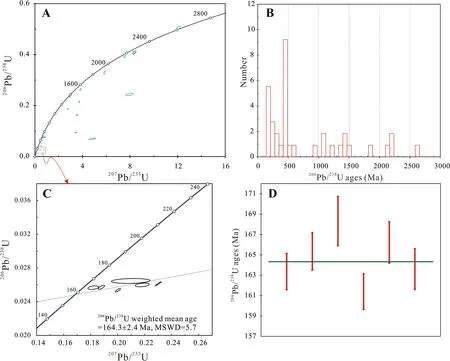
Fig.9 Zircon U-Pb dating plot of the granitoid.a Concordia plot for granitoid;b206Pb/238U age column of all zircons of granitoid;c concordia plot for~164 Ma of granitoid;d206Pb/238U average weighted age diagram of zircons in 164 Ma of granitoid
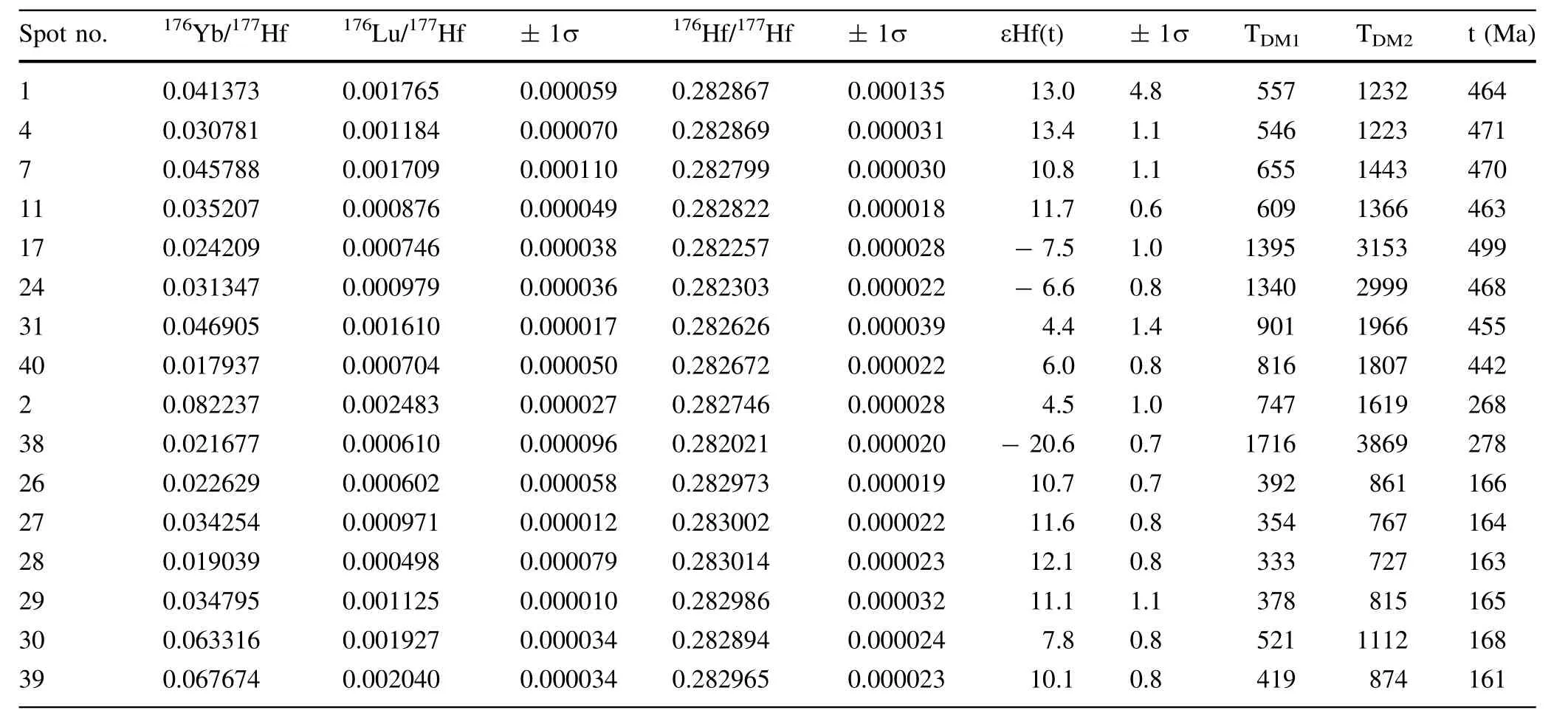
Table 3 Hf isotope data from zircons of the granitoid
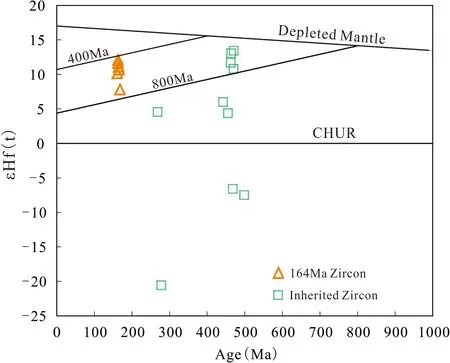
Fig.10 The relationship between age and εHf(t)of zircons of the granitoid
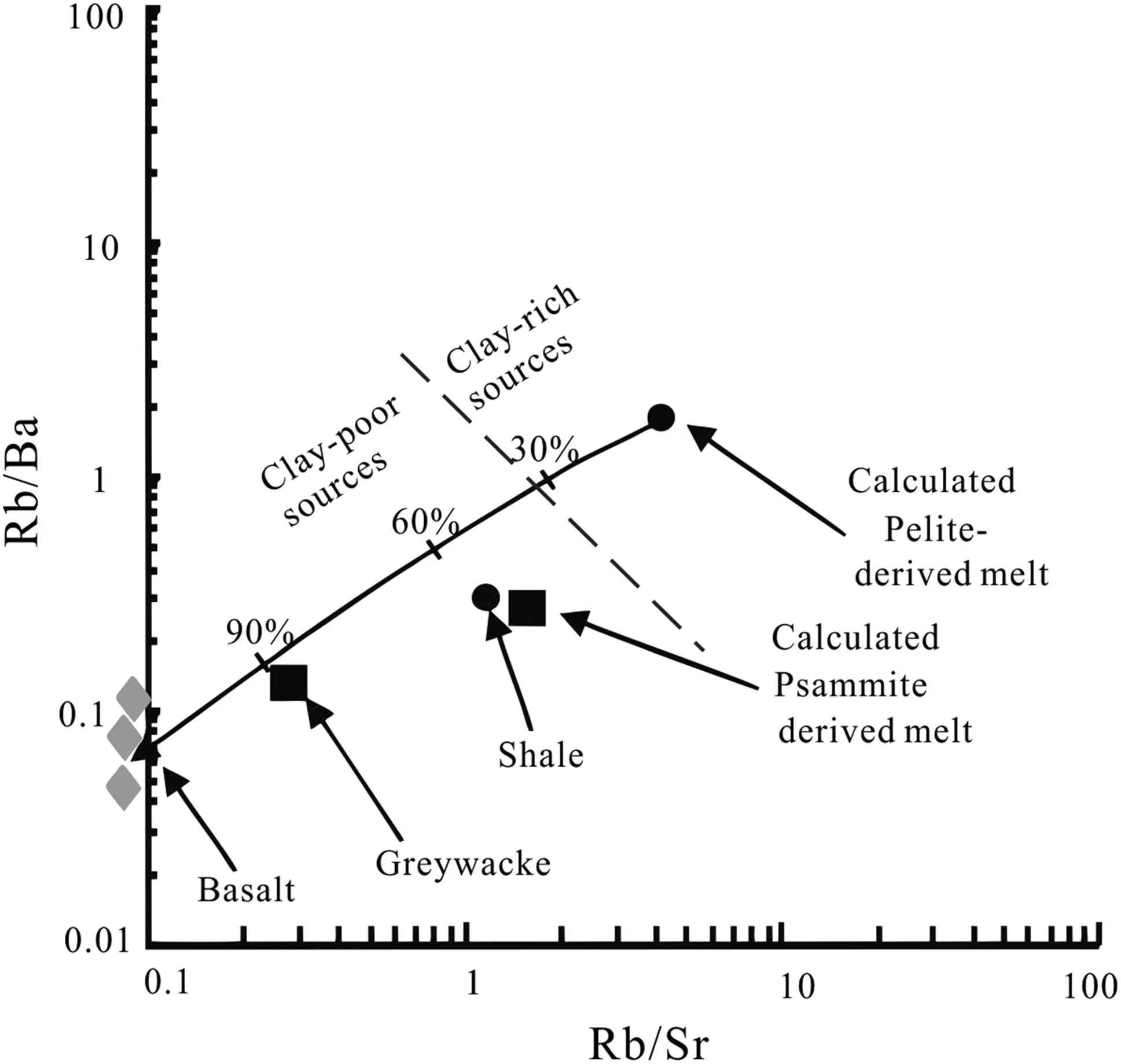
Fig.11 The Rb/Sr-Rb/Ba diagram of the granitoid(after Sylvester 1998)
Six zircons in 161-168 Ma with the εHf(t)from+7.8 to+12.1(Fig.10)showed that their source rocks mainly derived from the newly grown basaltic crust,and the Rb/Sr-Rb/Ba diagram also shows that the source magma of the gratinoid was from basalt(Fig.11).The various age peaks of inherited magmatic zircons(257-280 Ma,407-499 Ma,975-1105 Ma,1405-1520 Ma,~1800 Ma,2135-2280 Ma and~2632 Ma)is the strongest evidence of the adopted petrogenetic model involving crustal contamination,all the inherited zircons were captured during the intrusion of magma.Furthermore,the TDM2model ages(1112-727 Ma)of the granitoid dike indicate a relatively large crustal residence time,which may mean that the large anatexia processes and crustal rework in the southwest Yangtze block.It could be calculated through the Zirconium-saturated thermometer(Watson and Harrison 1983)that the granitoid in Luodian had a high temperature of about 950°C in crystallization.The high temperature may also indicate that the granitoid may have originated from the partial melting of the mantle or lower crust.Experimental petrological evidence shows that direct partial melting of the mantle peridotite can only form the igneous rock whose silica content was not higher than that of andesite(Baker et al.1995;Green 1973).Therefore,Luodian granitoid was not solely formed by partial melting of mantle peridotite directly.However,since the basic magma is formed by partial melting of mantle peridotite,this may have produced granite magma after assimilation contamination ofcrust-derived materialswhich then experienced strong crystallization and differentiation(Kemp et al.2007;Li et al.2009a,b).The granitoid dike in Luodian enriched LILE but depleted HFSE,which also suggestscrustalcontamination.A large numberof xenocrystic zircons have been discovered,indicating its contamination by hypabyssal crustal-derived materials in the diagenetic process.The granitoid dike also had low contents of Fe,Mg,and Ca,suggesting that it experienced strong crystallization differentiation,maybe experiencing the crystallization differentiation of mafic minerals(olivine and pyroxene).It depleted Ti and P,indicating that it may experience the crystallization differentiation of rich titanium minerals and apatite(Zhong et al.2009).
6.3 Dynamic background and its metallogenic implication
The granitoid intruded as the dike,indicating that it was formed in the stretching environment.The tectonic environment discrimination diagram showed that Luodian granitoid was mainly produced in the intraplate granite area(Fig.12),indicating that it may have been formed in the stretching environmentafterintraplate orogeny.The intraplate orogeny stage was accompanied by the mineralization.In this stage,the extrusion tectonics of crust and mantle could lead to the horizontal migration of the orebearing fluid,which may be favorable to mineralize at the stress release area(Luo et al.2007).At the stage of largescale magmatic activities at the orogenic belt,it is generally unlikely to form large deposits,but at the end of orogenesis or the post-tectonic stretching stage,it is favorable to mineralization(de Boorder et al.1998).Great mineralization has been developed in the southern Guizhou province(Hu and Zhou 2012),such as Carlin-type Aumineralization,whose metallogenic age spans largely from 143 to 193 Ma.Some studies have shown that the mineralization source may be associated with magmatism(Su et al.2009;Xia et al.2009;Liu et al.2017),but there are few reports on Jurassic igneous activities.The granitoid dike in Luodian has very obvious characteristics of mantlederived lower crust magma,indicating that in the Jurassic period(ca.164 Ma),intracontinental extension happened in the south of Guizhou,with the intrusion of mantlederived materials into the shallow crust.This discovery indicates that some mantle-derived materials have risen to the shallow crust through the fault,which provides the possible genesis for the greatly valuable hydrothermal deposits in the southwest of Guizhou in this period and has important significance to re-recognize the magmatic rocktectonic evolution and mineralization in the south of Guizhou and neighboring areas.
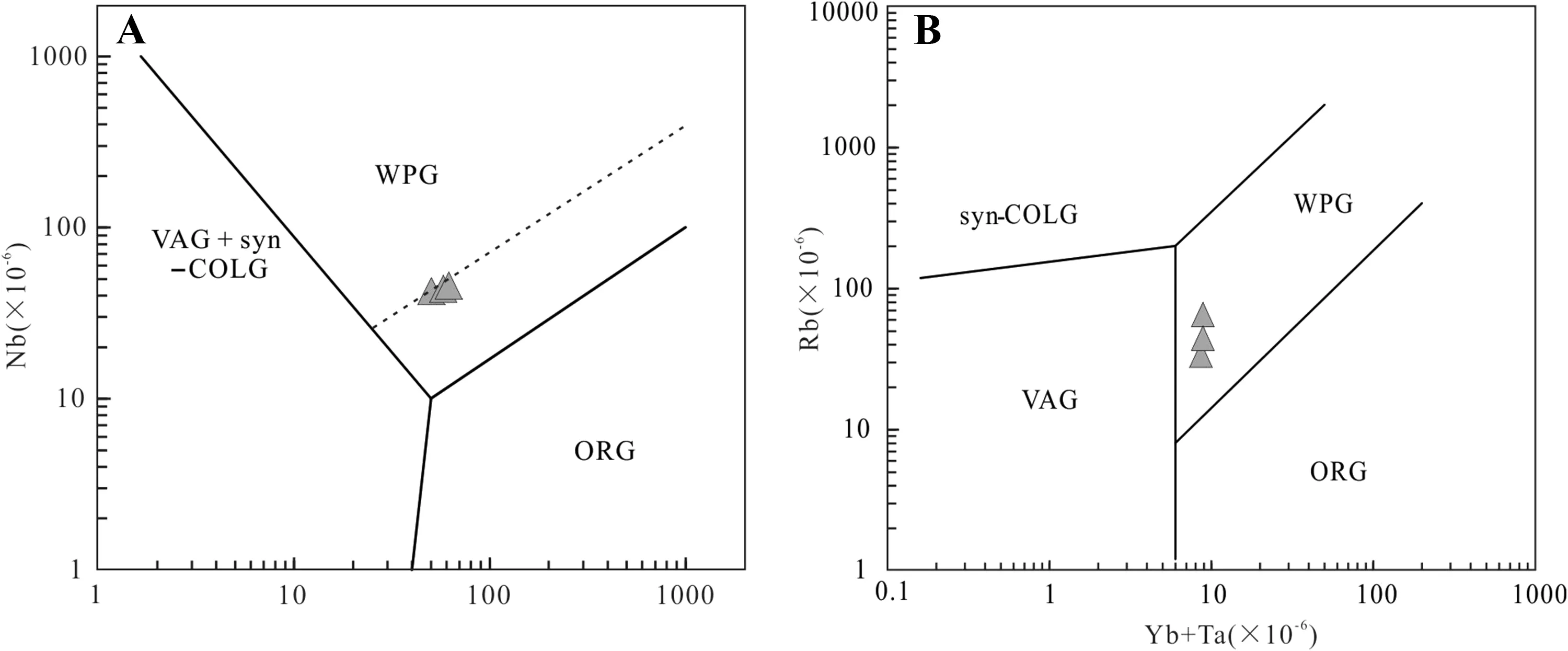
Fig.12 Tectonic environment diagrams of the granitoid(modified after Pearce et al.1984).WPG-intraplate granite;VAG-volcanic arc granite;Syn-COLG-Syn-collision granite;ORG-oceanic ridge granite;the dotted line is the boundary line of abnormally ORG
7 Conclusions
1. Zircon U-Pb dating showed that the age of the granitoid dike in Luodian was about 164 Ma.
2. The granitoid dike's concentration of rich alkali granite,its positive εHf(t)value of+7.8 to+12.1,and its great number of older inherited zircons,indicates that the granitoid dike was formed from the partial melting of newly grown basaltic crust,and then experienced crustal contamination and strong fractional crystallization.
3. The granitoid belongs to intra-plate origin,which is formed in the post-tectonic stretching stage.It indicates that in this period,a large number of mantlederived materials rose to the shallow crust,which may contribute to regional mineralization in the south of Guizhou and neighboring areas.
AcknowledgementsWe sincerely thank Prof.Zhang Zhuru,Prof.Zhang Xinchun and Prof.Su Wenchao for insightful suggestions,Prof.Li Mingqin,Prof.Xie Hong and Dr.Gao Junbo for lab assistance and Dr.Huang Zhiyong and Engineer Hao Jiaxu for the fieldwork.This research was funded by grants from the National Natural Science Foundation of China(No.41262005),high-level personnel of Guizhou Institute of Technology(No.XJGC20140702)and Talent introduction project of Guizhou University(No.702400163301).
- Acta Geochimica的其它文章
- Acta Geochimica
- Comprehensive geochemical/hydrochemical and geo-thermometry analysis of Unai geothermal field,Gujarat,India
- Prospectivity modeling of porphyry copper deposits:recognition of efficient mono-and multi-element geochemical signatures in the Varzaghan district,NW Iran
- Synthesis of zinc oxide-montmorillonite composite and its effect on the removal of aqueous lead ions
- Petrology,geochemistry,radioactivity,and M-W type rare earth element tetrads of El Sela altered granites,south eastern desert,Egypt
- The metallogenic environment of the Dounan manganese deposit,Southeast Yunnan,China:evidence from geochemistry and M?ssbauer spectroscopic

